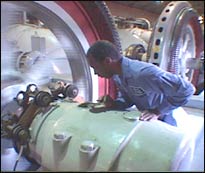That's why Walter Maestri and his colleagues are getting ready at the emergency command center in Jefferson Parish. He says if the hurricane comes, they'll seal themselves inside.
"This is the communications center here—at every station we've got fire, we've got emergency medical, National Guard…" explains Maestri.
| |

Jefferson Parish Emergency Management. Photo: William Brangham/NOW with Bill Moyers |
Maestri says imagine what happens if a huge storm hits just to the east of the city.
"The hurricane is spinning counter-clockwise, it's now got a wall of water in front of it some 30 to 40 feet high, as it approaches the levees that surround the city, it tops those levees," describes Maestri. "The water comes over the top - and first the communities on the west side of the Mississippi river go under. Now Lake Ponchetrain— which is on the eastern side of the community—now that water from Lake Ponchetrain is now pushed on the population that is fleeing from the western side, and everybody's caught in the middle. The bowl now completely fills and we've got the entire community under water, some 20 to 30 feet under water."
Remember all those levees that the U.S. Army built around New Orleans, to hold smaller floods out of the bowl? Maestri says now those levees would doom the city, because they'll trap the water in.
"It's going to look like a massive shipwreck," says Maestri. "Everything that the water has carried in is going to be there. It's going to have to be cleaned out— alligators, moccasins and god knows what that lives in the surrounding swamps, has now been flushed -literally—into the metropolitan area. And they can't get out, because they're inside the bowl now. No water to drink, no water to use for sanitation purposes. All of the sanitation plants are under water and of course, the material is floating free in the community. The petrochemicals that are produced up and down the Mississippi river—much of that has floated into this bowl... The biggest toxic waste dump in the world now is the city of New Orleans because of what has happened."
Planning for Disaster
The U.S. Army Corps of Engineers runs its own command post right on the banks of the river. And federal officials have ordered them to figure out, 'What would it take after a disaster to get New Orleans back in shape?'

Jay Combe is assembling his findings in a three-ring notebook. Photo: William Brangham/NOW with Bill Moyers | |
You'll find the Army Corps's chief researcher Jay Combe behind a warren of gray cubicles; he's assembling his findings in a three-ring notebook.
"Each of these maps shows a different area," says Combe. "This shows where you flew in ... "
Combe says nobody in America has confronted these issues across an entire city. Not after an earthquake. Not after floods. Not after September 11.
"Street signs will be gone," he explains, "things that you know like, 'I'm going to go down to the corner of Broadway and St. Charles'—that place won't be there anymore."
So he's mapping the crucial structures in the city with longitude and latitude, because he says emergency crews will have to use navigation devices just to find where they are.
| |

New Orleans operates one of the biggest pumping systems on earth. Jay Combes says that system won't work after a huge hurricane. Photo: William Brangham/NOW with Bill Moyers |
Combe looks like Santa Claus with a tie. It's especially unnerving to hear him talk about disaster. He's trying to figure out, for instance, how will emergency workers start working in a city that's drowned in an 80-mile lake? New Orleans has protected itself from past floods partly with the levees, but the city also operates one of the biggest pumping systems on earth. There are giant turbines all across town, and every time there's a major rain, they suck up the water and pump it out. Combes says that system won't work after a huge hurricane.
"The problem," says Combe, "is that the city's been underwater. And the whole city has to be drained by the pumps, and since the pumps have been under the water, the pumps are flooded. They don't operate now— we have to get the pumps back in operation and in order to get the pumps back in order, we have to get the water out of the city."
Sounds like a Catch 22.
"That's correct."
Next: Terrible Devastation

